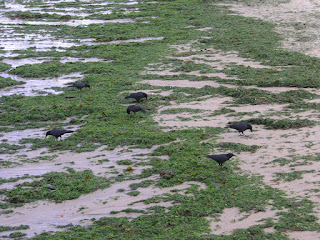

Just in time for Halloween! This tarantula was crossing the road and of course we stopped. I'm fairly sure it's a male, because some of my numerous pictures clearly show spurs on the underside of the front "knees." As big as he seemed, his cephalothorax was not much bigger than a dime. When I touched his back legs, he'd arch his abdomen up and spread out his spinnerets. He was very camera friendly and would walk toward me when I got down on the ground to take pictures. We tried to herd him to the side of the road, but he seemed to prefer roaming around on the road... which was terribly unfortunate. As we were leaving him to his thing, he got squished by a passing car. I almost cried.
While I believe this is an
Aphonopelma eutylenum, I've e-mailed Brent Hendrixson at The American Tarantula Society to confirm and will update this post when I hear back. For more photos, see
my Flickr set.
ps 11/01/10 - For other regionally local tarantula sightings, check out
Idora Design,
Nature Visions, and
Dipper Ranch.
pss 11/12/10 - Again, another tarantula post, not necessarily local,
Weird Bug Lady's blog post.
pss 11/15/10 - I heard back from Brent after sending a second e-mail without a photo attachment. With his permission, here's what he said, "This is a tough group of spiders. The species belongs to what we call the "Aphonopelma eutylenum" species complex, a group of several closely related species whose identities remain elusive because they are difficult to distinguish (in fact, I think they're more than likely all the same species). I know this isn't terribly helpful, but that's where we're at with this group right now." Thank you, Dr. Hendrixson!

 Corral de Tierra
Corral de Tierra











